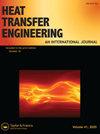提高微通道散热器热性能的沟槽结构优化
IF 1.6
4区 工程技术
Q3 ENGINEERING, MECHANICAL
引用次数: 0
摘要
摘要在目前的工作中,对沟槽式微通道散热器在沟槽内不同偏移位置的热性能进行了评估。为此,建立了基于欧拉-欧拉方法的数学模型,并采用有限体积法进行了数值求解。水是添加氧化铝纳米颗粒以增强传热的基础流体。研究了雷诺数(100 ~ 1000)、颗粒直径(10 ~ 50 nm)、沟槽数(10 ~ 80)、沟槽间偏移量(0 ~ 1)和颗粒体积分数(0% ~ 5%)对微通道无量纲压降、努塞尔数和性能系数的影响,并量化了它们对微通道热特性的影响。最重要的是,对比了对称槽(偏移量= 0)和非对称槽(偏移量≠0)的微通道,发现偏移槽对微通道性能的影响不显著。此外,我们还提出了一个经验相关性来评估对称和非对称微通道的性能系数作为输出变量的函数。免责声明作为对作者和研究人员的服务,我们提供了这个版本的已接受的手稿(AM)。在最终出版版本记录(VoR)之前,将对该手稿进行编辑、排版和审查。在制作和印前,可能会发现可能影响内容的错误,所有适用于期刊的法律免责声明也与这些版本有关。潘卡吉·库马尔是印度泰米尔纳德邦金奈603203卡坦库拉图尔SRM科学技术研究所机械工程系的研究助理教授。在过去的十年里,他一直从事两相流和传热方面的研究。他在国际期刊上发表了16篇研究论文,主要研究空化、两相流和圆柱流。Vishnu Teja Mantripragada是贾坎德邦丹巴德印度理工学院燃料、矿产和冶金工程系的助理教授。印度。在过去的七年里,他一直从事多相流和计算流体动力学的研究。他在国际期刊上发表了12篇关于多相流、输运现象、液滴和气泡的研究论文。本文章由计算机程序翻译,如有差异,请以英文原文为准。
An optimization of grooves structure for thermal performance enhancement in microchannel heat sink
ABSTRACTIn the current work, the thermal performance of a grooved microchannel heat sink is evaluated at different offset positions inside the channel. For this purpose, the Eulerian – Eulerian approach-based mathematical model is developed and is numerically solved using the finite volume approach. Water is the base fluid to which alumina nanoparticles were added to enhance heat transfer. The effect of the Reynolds number (100-1000), particle diameter (10 nm- 50 nm), the number of grooves (10-80), offset between the grooves (0-1), and particle volume fraction (0% -5%) on the dimensionless pressure drop, Nusselt number, and coefficient of performance are investigated, and their impact on the microchannel's thermal characteristics is quantified. Most importantly, the microchannels with symmetric (Offset = 0) and asymmetric grooves (Offset ≠ 0) were compared, and it was found that offsetting the grooves has an insignificant effect on the microchannel performance. Furthermore, an empirical correlation is proposed to evaluate the coefficient of performance of both symmetric and asymmetric microchannels as a function of the output variables.DisclaimerAs a service to authors and researchers we are providing this version of an accepted manuscript (AM). Copyediting, typesetting, and review of the resulting proofs will be undertaken on this manuscript before final publication of the Version of Record (VoR). During production and pre-press, errors may be discovered which could affect the content, and all legal disclaimers that apply to the journal relate to these versions also. Additional informationNotes on contributorsPankaj Kumar Pankaj Kumar is a Research Assistant Professor in the Department of Mechanical Engineering, SRM Institute of Science and Technology, Kattankulathur, Chennai-603203, Tamilnadu, India. He has been working in two-phase flow and heat transfer for the past ten years. He has published 16 research papers in international journals focusing on cavitation, two-phase flows, and flow past a circular cylinder.Vishnu Teja Mantripragada Vishnu Teja Mantripragada is an Assistant Professor in the Department of Fuel, Minerals and Metallurgical Engineering, IIT (ISM) Dhanbad, Jharkhand. India. He has been working in multiphase flows and computational fluid dynamics for the past seven years. He has published 12 research papers in international journals focusing on multiphase flows, transport phenomena, droplets, and bubbles.
求助全文
通过发布文献求助,成功后即可免费获取论文全文。
去求助
来源期刊

Heat Transfer Engineering
工程技术-工程:机械
CiteScore
4.50
自引率
17.40%
发文量
111
审稿时长
7.5 months
期刊介绍:
Publishing 18 issues per year, Heat Transfer Engineering is an unparalleled resource for key advances in the field of heat transfer for the practicing engineer and other workers in the field. The journal publishes analytical, numerical, and experimental articles of lasting interest in the general area of heat-mass transfer and the related fluid mechanics and thermodynamics.
In a clear, easy-to-read format, the journal includes refereed papers of original work, state-of-the-art reviews, articles on new developments in equipment or practices, reviews of fundamentals, heat in history articles, book reviews, news items on people and companies in the field, advertising, and any other items that may be appropriate.
All submitted manuscripts are subject to initial appraisal by the Editor and/or selected members of the Editorial Board, and, if found suitable for further consideration, to peer review by independent, anonymous expert referees.
 求助内容:
求助内容: 应助结果提醒方式:
应助结果提醒方式:


